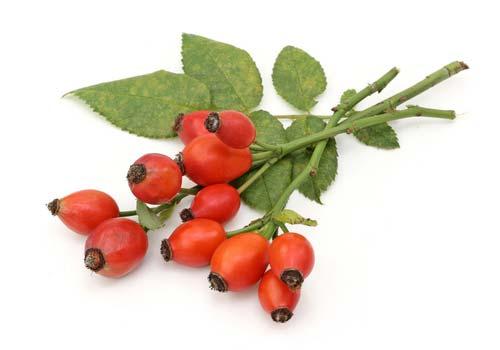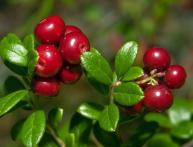Rose hips - a storehouse of vitamins

Since time immemorial, people have discovered a wonderful useful plant - the rose hip. Even in the time of Hippocrates, its fruits began to be actively used as a folk way of combating ailments. And to this day, decoctions from its roots and fruits remain the most popular methods for relieving the symptoms of many diseases.
Content:
- Description of the plant
- Application and healing properties
- Folk recipes for decoctions
- Rosehip for weight loss
Description of the plant
The common rose hip, or as it is also called the dog rose, is a shrub from the Rosaceae family. An adult plant reaches a height of 2 m. The bush consists of numerous thin twig-like branches with shiny purplish-red bark.
A characteristic feature of a plant from Rosaceae family is the presence of curved spines located at the base of the leaves. The leaves themselves are oblong in shape with short petioles. The inflorescences are large, solitary and usually reach a diameter of 3-5 cm.
Sometimes you can find double or triple flowers. The inflorescences of the common rose hips are scarlet-red, framed by a green calyx and have numerous stamens and pistils. Common rose hips bloom from mid-May to July. As a result, oval fruits are formed, shaped like small acorns. The color of the fruit depends on the climate of the bush and ranges from pale orange to bright red.
Usually the fruits are small, but individual berries reach 1.5 cm in size.Harvest period is August, September. The fruits can be collected after the first frost, however, this impairs their beneficial properties. After frost, the content of ascorbic acid in fruits decreases slightly.

They harvest by hand, trying not to crush them, as if the skin is damaged they quickly become moldy. Before drying, the raw materials are sorted out and damaged or unripe fruits are thrown away. If the fruits are picked frozen, they cannot be thawed under any circumstances, as this will harm the quality.
They are placed in the oven frozen for drying, and during the process they are constantly turned over so that the fruits do not burn. Dried rose hips are dark red in color and are ready for long-term storage - up to two years. In general, it is not recommended to start drying fruits immediately after harvesting.
You need to wait two or three days, that is let the fruits rest in a cool, dark place.
The common rose hips are found almost everywhere in our country. Its main place of growth is the European part, but it can often be found in the Urals and Siberia. The shrub is unpretentious, so it is found in river floodplains, in flooded meadows, in clearings and ravines, in open glades and along forest edges.
Recently it is often found in garden plots. People love rosehip for its beautiful inflorescences and healthy fruits, so they cultivate it as an ornamental, medicinal and vitamin plant.
Application and healing properties
The fruits of the rose hips have medicinal uses. Their pulp contains useful vitamins and minerals, such as:
- Vitamins C, B2, K, P
- Provitamin A
- Sahara
- Pectins
- Citric and malic acids
The fruits of the plant are used in cooking. They are added to dishes for vitaminization. They make puree and willow paste. Some confectionery factories add rose hips when producing marmalade and sweets. But more often they are used in the preparation of compotes, jelly, fruit drinks and kvass.
It is known that extracts from rose hips accelerate the secretion of bile. Therefore, extract from rose hips is used pharmacologically and in folk medicine for the prevention and treatment of inflammation of the liver and gall bladder. Extracts from fruits are intended to reduce various bleedings such as hemophilic and hemorrhagic.
Rosehip is useful for those who have undergone surgery, as well as during prolonged physical activity and stress. Doctors advise pregnant and breastfeeding women, and anyone who suffers from atherosclerosis, inflammation of the bronchi, lungs and tuberculosis to take medications or infusions containing rosehip extracts.
In addition, rose hips are indispensable for gastritis and ulcers, intestinal disorders and inflammatory processes of the duodenum. Since rose hips stimulate the kidneys, it is prescribed for corresponding diseases of the genitourinary system. Often, for disorders of the digestive tract, doctors prescribe taking an aqueous infusion of leaves. It is believed to stimulate the stomach and relieve pain.
Rosehip leaves contain phytoncides that have a disinfecting effect. Therefore, compresses from the leaves are applied to the skin for purulent wounds. It has been proven that an infusion of rosehip leaves has a beneficial effect on the skin, so it is actively used in cosmetology for tonic procedures.
In medicine, preparations based on rosehip extracts, obtained not only from the fruits and leaves, but also from the roots of the plant, are prescribed for viral diseases such as malaria. It turns out that the roots contain tannins, which, when entering the body, bind and remove toxins.
Rosehip seeds are also useful. Oil is squeezed out of them, which is rich in fatty acids and vitamins. Oil compresses are applied to open wounds or purulent ulcers. It is useful for burns and frostbite. Rosehip oil heals small wounds and cuts well and is also actively used in dentistry to relieve gum inflammation.
Thus, a well-known and widespread plant turns out, without exaggeration, to be a real storehouse of vitamins and minerals. Rosehip is a surefire remedy in the fight against numerous ailments, time-tested.
Folk recipes for decoctions
All kinds of pills, extracts, extracts and water infusions from rose hips are used to treat and prevent various disorders that occur in the body due to a lack of vitamins (mainly group C), which leads to exhaustion and anemia.
A convenient dosage form that can be easily prepared at home is an infusion.
Today there are quite a lot of cooking recipes. You can brew not only fruits, but also leaves, shoots and roots. The essence of all recipes comes down to the fact that a certain amount of prepared plant material is poured with boiling water and left for a while:
- Recipe No. 1. Pour a couple of tablespoons or 20 g of dried rose hips with 1 cup of boiling water. Boil the mixture in a covered enamel pan for 10 minutes. Let it brew for 24 hours.Strain the broth through double gauze and squeeze out the fruits. The drink is ready, take 1/2 cup orally twice a day.
- Recipe No. 2. Grind 20-40 g of dried rose hips in a mortar or blender. Brew boiling water (2 cups) and strain everything into a thermos. Leave for about 10-12 hours, then take half a glass twice a day before meals. This infusion can be given to children, adding syrup to it if desired.
- Recipe No. 3. Decoction of rosehip roots: 1 tablespoon of crushed roots per 1 cup of boiling water. Boil for no more than 15 minutes over low heat. Leave for several hours, but do not cool and strain. Be sure to drink it warm, so it’s best to keep the infusion in a thermos.
- Recipe No. 4. Rose hip liqueur: 1 cup of fruit, 1.5 cups of sugar and 3 cups of vodka. Mix everything and leave it in the sun for several days. When 5 days have passed, pour in 2 glasses of vodka. Leave for another 5 days. Filter the composition using gauze and squeeze out the fruits, then take 15-20 g daily after meals.
Decoctions and infusions They help very well with various ailments, improve overall well-being, and also have a pleasant sour taste. In addition, the preparation process is not complicated at all, and if desired, you can improve the taste of the drink with sugar or honey.
Rosehip for weight loss

It has been proven that rose hips contain organic acids that accelerate metabolism and promote the burning of fat deposits. Therefore, recently, rosehip decoctions have been actively used to maintain normal weight and fight the hated kilograms.
Of course, you shouldn’t rely only on the wonderful properties of rose hips. The weight won't just go away.Additionally, you need to monitor the amount of calories you consume and perform at least minimal physical exercise for all muscle groups. Without physical activity, the skin will stretch and sag as extra pounds are lost.
For weight loss, not only rose hips are used, but also leaves, petals and roots. How to use rose hips to get rid of fat reserves? The answer is simple: prepare decoctions and infusions. You can drink them in pure form, or you can add them to tea or compote. The main thing is to drink a freshly prepared decoction every day before each meal. You can't drink yesterday's drink!
There is a rosehip diet developed by leading nutritionists specifically for those who urgently need to lose weight. The menu is quite strict and involves excluding all fatty foods and “goodies”. For 10 days you will need to constantly drink rosehip decoction without adding sugar or honey.
It is believed that in ten days of such a diet you can lose 10 extra pounds. However, such a sudden weight loss can adversely affect your well-being. Therefore, doctors strongly recommend repeating the rosehip diet no earlier than after a year.
In addition, for some people, taking large amounts of rosehip decoction is contraindicated. If you have certain diseases, the substances contained in the decoction can provoke their exacerbation. The rosehip diet should be abandoned if you have heart and vascular diseases, chronic gastritis or kidney dysfunction.
In the case of a competent approach in the fight against excess weight, taking decoctions and infusions of rose hips has the desired effect. Do not forget that good physical shape directly depends on a balanced diet and an active, healthy lifestyle.
It is obvious that rosehip is a real storehouse of vitamins and an indispensable assistant for any ailment. This is the first remedy for minor household injuries, abrasions and cuts, as well as a wonderful preventive and restorative herbal remedy, which would be nice to always have on hand.
Watch the video for all the benefits of rose hips:
Interesting information about the vegetable garden











Comments
We have rosehip bushes planted in our yard as a fence from cars in the area where children play - such a fence looks very beautiful. And good. that the drivers in the yard are conscientious, because the bushes are not a concrete fence, and it won’t take long to break them.
Rose hips are very good to use in tea, especially closer to autumn, when immunity begins to decline. The good thing about the plant itself is that you don’t need to care for it, it grows as if by itself.
My husband went on vacation to Yarovoye. There are a lot of rose hips growing there. He brought a whole bag of fruits to dry. And the fruits turned out to be infected... How can this be?